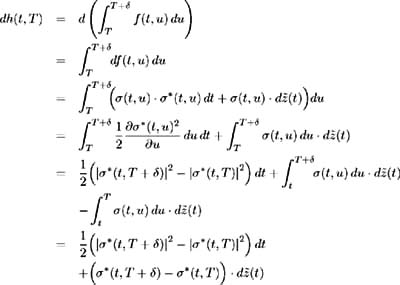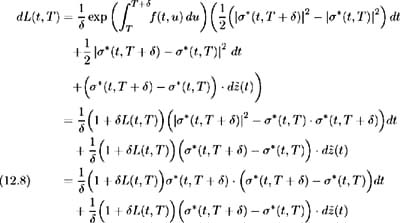12.3 Model of the forward LIBOR rate
12.3 Model of the forward LIBOR rate
Specifying the above model of the instantaneous, continuously compounded forward rate is equivalent to determining the volatility function ƒ ( t, T )(or equivalently ƒ *( t, T )). Fix some > 0, then the LIBOR rate process { L ( t, T ); t ˆˆ [0, T ], T ˆˆ [0, ]} is defined as:
Imposing a lognormal volatility structure on L ( t, T ), the associated stochastic process may be written as:
where ¼ L ( t, T ) is some drift function and ³ : R 2 ’ R n is the deterministic, bounded and piecewise continuous relative volatility function. Letting h ( t, T )= ( ˆ« T + T f ( t, u ) du , we make use of Ito's Lemma to determine the correct functional form of (12.6). Hence:
Here:

Therefore:

and (12.7) becomes:

Hence by (12.6) we require:

and so (12.8) may be written in terms of the ( T + )-maturity bond price volatility as:
Alternatively, solving (12.9) for ƒ *( t, T + ) we may write this LIBOR stochastic process in terms of the T -maturity bond price volatility as:

Now let us assume [6] ƒ *( t, T ) = 0 for all t ˆˆ ( T ˆ’ ) ˆ 0, T and T ˆˆ [0, ], then a recursive relationship may be used to define ƒ *( t, T )for T ˆ’ t ‰ as [7] :
Substituting this recursive relationship into (12.10), the stochastic process describing the evolution of LIBOR may be written purely in terms of LIBOR rate volatilities as:

Letting j = k ˆ’ 1 we have:

[6] This assumption implies the volatility factor disappears for all rates where 0 ‰ T ˆ’ t < , that is the time between valuation date and maturity date is less than . This allows for the construction of a tractable model. We have ƒ *( t, t ) = 0 for all t ˆˆ [0, T ] since this is the price volatility of an instantly maturing bond. Relationship (12.9) implies:
Hence, for T = t +
since ³ ( t, t ) = 0 is the volatility of the spot LIBOR rate. So, since ƒ *( t, T )=0 for T = t and for T = t + we let ƒ *( t, T ) = 0 for all T ˆˆ ( t, t + ) as well. This is equivalent to ƒ *( t, T )=0 for t ˆˆ ( T ˆ’ , T ).
[7] By (12.9) we have:

Since, by assumption, ƒ *( t, T )=0 for T ˆ’ t < the first term on the RHS vanishes for T ˆ’ t ˆ’ k < i.e. the term vanishes for k > ˆ’ 1 ( T ˆ’ t ) ˆ’ 1, hence the upper bound for the summation index is k = ˆ’ 1 ( T ˆ’ t ).
EAN: 2147483647
Pages: 132